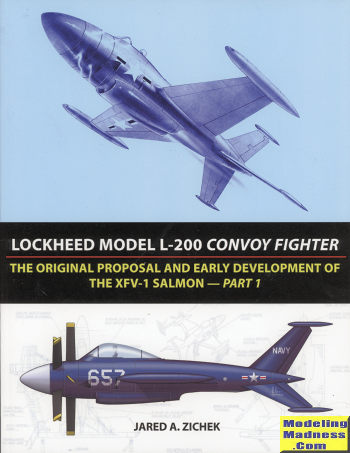 During the
last years of WWII and into the 1950s, the pace of aviation development was
staggering. Advances were coming so quickly that what was top of the line one
year, was nearing obsolescence just a few years later. It was also a time of
innovation where the military was not afraid to try something new and designers
were more than happy to stretch their abilities as well.
During the
last years of WWII and into the 1950s, the pace of aviation development was
staggering. Advances were coming so quickly that what was top of the line one
year, was nearing obsolescence just a few years later. It was also a time of
innovation where the military was not afraid to try something new and designers
were more than happy to stretch their abilities as well.
Such was the case of the Convoy Fighter. This was a plan to
allow ships in a convoy to carry a plane or two for self protection against
enemy bombers without the requirement for a large and expensive aircraft
carrier. The specifications called for a turboprop powered aircraft that could
land and take off vertically without the need for complex handling apparatus. It
should also be able to operate from a ship that was moving and so had to be able
to handle not only fore and aft movement but also side to side motion. These are
the motions that make most first time voyagers sea-sick.
Proposals were submitted by several companies and two were
chosen. These became the Convair XFY-1 and the Lockheed XFV-1. Both of these
planes flew, though only the Convair entry was able to take off and land
vertically. The main issue was the lack of power from available turboprop
engines and the difficulty of landing.
Had these proposals actually been able to overcome their
difficulties, it is conceivable that not only would these have made great close
infantry support aircraft, but would have been able to defend against the
perceived threats of the day. In some way, the modern Marine attack helicopter
is performing exactly the missions for which this aircraft was initially
conceived.
In this book, the author provides the first volume on
Lockheed's L-100 design which eventually became the XFV-1 'Salmon'. Lockheed put
a great deal of effort into producing a ready to go prototype that could quickly
become a production aircraft. In volume one, the development and early design
work on the aircraft is covered, including the specifications for the aircraft,
some very in-depth drawings and blueprints, the building of cockpit mock-ups and
the overall look of the aircraft.
The cockpit of these planes is especially interesting as it
had to be so designed that the pilot could maintain complete control in the
transition from vertical to level flight and vice versa. In Lockheed's design,
the entire cockpit section inside the airframe was designed to rotate 45
degrees. This provided the optimum comfort in terms of the pilot's abilities to
control the aircraft and to see where he was going. The aircraft was to be
equipped with small extendable spikes on the gear legs mounted in the fins that
would hook into a mesh on the deck. A ground handling apparatus would then grab
the plane and return it to the horizontal so the pilot could egress the plane
and so that maintenance could be more easily performed.
There is, of course, a lot more to the book that what I've
stated, but that should whet your appetite enough to order a copy.
July 2017
Copyright ModelingMadness.com. All rights reserved.
My thanks to
www.retromechanix.com for providing the review
sample. You can get a hard copy
on www.Amazon.com or an electronic
version from the first link.
If you would like your product reviewed fairly and fairly quickly, please contact
the editor or see other details in the Note to
Contributors.
Back to the Main Page
Back to the Books Index
Page
 During the
last years of WWII and into the 1950s, the pace of aviation development was
staggering. Advances were coming so quickly that what was top of the line one
year, was nearing obsolescence just a few years later. It was also a time of
innovation where the military was not afraid to try something new and designers
were more than happy to stretch their abilities as well.
During the
last years of WWII and into the 1950s, the pace of aviation development was
staggering. Advances were coming so quickly that what was top of the line one
year, was nearing obsolescence just a few years later. It was also a time of
innovation where the military was not afraid to try something new and designers
were more than happy to stretch their abilities as well.